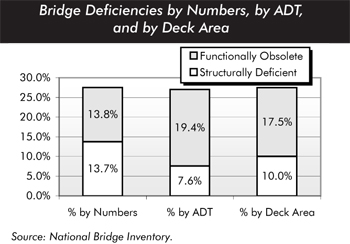
Bridges
Bridges are critical elements within the highway transportation network, supporting commerce, economic vitality, and personal mobility. There are 591,707 bridges over 20 feet in length located on public roads in the United States, carrying nearly 4 billion vehicles per day. Of this total, 27.5 percent are classified as structurally deficient or functionally obsolete. Structural deficiencies result primarily from deteriorated conditions on the primary components of a bridge. These structures typically require significant maintenance and repair to remain in service. While 13.7 percent of bridges are structurally deficient, these bridges constitute only 10.0 percent of total bridge deck area and carry only 7.6 percent of bridge traffic. A functionally obsolete bridge generally is one that no longer meets current geometric and structural standards for the highway on which it is located.

The Nation's highway bridges have remained safe as a result of the development of the National Bridge Inspection Standards and associated funding programs of the bridge programs, and progress has been made in reducing deficiencies. However, with an ever-aging population of highway structures and increasing traffic demands, it is important to examine transportation system preservation strategies, such as preventative maintenance, and improved bridge inspection and management techniques to continue to ensure the safety of the motoring public and effective stewardship of the public trust.

